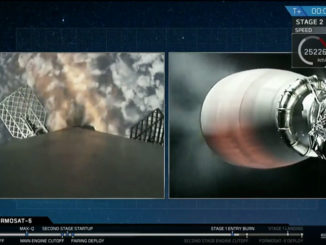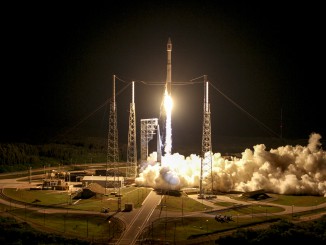EDITOR’S NOTE: Updated at 11:30 p.m. EDT (0330 GMT) after confirmation of a successful mission.

On its first launch of the year, a Russian-made Proton rocket lifted off Thursday from the Baikonur Cosmodrome in Kazakhstan with a French-built, Russian-owned communications satellite.
The 191-foot-tall (58-meter) Proton rocket lifted off at 1742 GMT (1:42 p.m. EDT; 10:42 p.m. Baikonur time) Thursday to carry the Yamal 601 spacecraft toward a perch in geostationary orbit more than 22,000 miles (nearly 36,000 kilometers) over the equator.
Mounted on a mobile rail transporter, the Proton rocket, its Breeze M upper stage and the Yamal 601 communications satellite departed a hangar at the Central Asia space base around sunrise Monday.
After arriving at the launch pad, hydraulic lifts raised the Proton rocket vertical and mobile towers enclosed the launcher for final pre-flight checkouts.
Thursday’s launch was the first Proton flight of the year, and the 419th Proton rocket launch since the vehicle’s debut in 1965. It was the fourth launch this year from the Baikonur Cosmodrome, a sprawling facility in Kazakhstan leased by the Russian government.
While Thursday’s mission carried a quasi-commercial communications satellite, the launch was not conducted under the auspices of International Launch Services, the Russian-owned, U.S.-based firm responsible for marketing Proton launch services on the global market.
The Russian government considered the launch of Yamal 601 as part of the country’s federal space program.
The Yamal 601 satellite is owned by Gazprom Space Systems, a provider of satellite communications to Russian homes, businesses and the government, and a daughter company of oil giant Gazprom.
Designed for a 15-year mission, the spacecraft was built by Thales Alenia Space of France, and is based on the Spacebus 4000C4 platform. Fully fueled, the Yamal 601 spacecraft weighs around 11,900 pounds, or 5.4 metric tons, according to Thales Alenia Space.
Yamal 601’s C-band payload, which consists of 18 transponders, will replace coverage previous supplied by the Yamal 202 satellite launched in 2003. The C-band transponders will cover Russia, neighboring countries in Eastern Europe and Central Asia, the Middle East, and part of Southeast Asia.
According to Thales Alenia Space, a Ka-band payload on-board Yamal 601 will expand Gazprom’s coverage, with 32 spot beams over Western Russia and West Siberia to provide high-speed broadband connectivity to companies, regional governments, and individual consumers.

After liftoff from Site 200 at Baikonur, the Proton rocket turned northeast powered by six RD-276 liquid-fueled main engines, generating some 2.5 million pounds of thrust as the launcher climbed into the upper atmosphere.
Two minutes after launch, the Proton’s first stage shut down and separated to fall back to the ground in Kazakhstan. Four engines on the rocket’s second stage took over and burned until T+plus 5 minutes, 27 seconds. Moments later, the Proton’s third stage ignited to place the Yamal 601 spacecraft and the Breeze M upper stage on a suborbital trajectory.
Russian officials confirmed a good separation of the Breeze M upper stage less than 10 minutes after liftoff. The Breeze M’s main engine was then programmed to fire five times, first to reach a preliminary low-altitude parking orbit, then to maneuver Yamal 601 into an elliptical geostationary transfer orbit with a high point more than 20,000 miles above Earth.
Separation of the Yamal 601 satellite from the Breeze M upper stage was scheduled more than nine hours into the mission, at 0255 GMT (10:55 p.m. EDT).
Russia’s space agency, Roscosmos, announced the Breeze M upper stage released the Yamal 601 satellite into the targeted orbit, and officials declared the mission a success.
Yamal 601’s on-board engine will circularize its orbit at geostationary altitude — around 22,000 miles over the equator — at 49 degrees east longitude, where it will take over for Yamal 202.
The launch of Yamal 601 will be followed June 21 by the next Proton mission, set to loft the Russian-German Spektr-RG X-ray astronomy observatory toward an observing point nearly a million miles (1.5 million kilometers) from Earth.
Email the author.
Follow Stephen Clark on Twitter: @StephenClark1.



